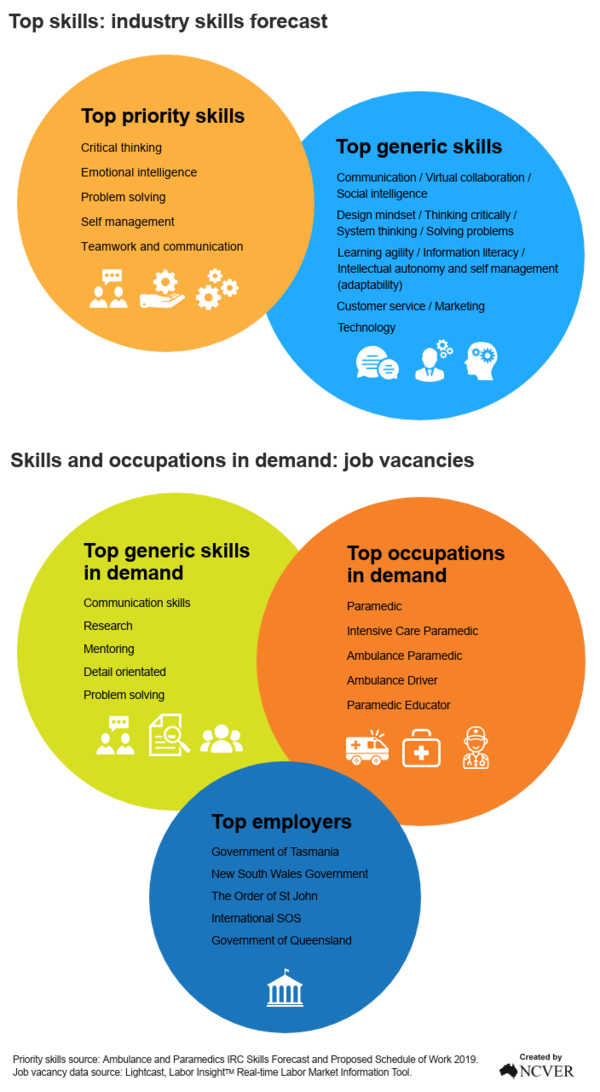
Industry insights on skills needs
The Ambulance and Paramedic IRC's 2019 Skills Forecast was the most recently published skills forecast by the IRC, as of September 2022. It identified the top priority skills for the sector as critical thinking, emotional intelligence, problem solving, self-management, and teamwork and communication.
The top five identified generic skills are:
- Communication / Virtual collaboration / Social intelligence
- Design mindset / Thinking critically / System thinking / Solving problems
- Learning agility / Information literacy / Intellectual autonomy and self-management (adaptability)
- Customer service / Marketing
- Technology.
According to the job vacancy data, the top requested skills by employers in the sector were communication skills, followed by research and mentoring. The top occupations were Paramedic, followed by Intensive Care Paramedic. The top employers were the Tasmanian Government, followed by New South Wales Government and the Order of St John.
According to the Ambulance and Paramedic IRC's 2019 Skills Forecast the sector has been experiencing several challenges which are impacting workforce skills requirements, including:
- Skills shortages and the need to consider work-integrated learning to better transition graduates into practice
- Retention of staff through wellbeing and resilience of the workforce
- Government policy/legislative changes and the impact the National Registration and Accreditation Scheme will have on the future workforce
- An ageing population and an increased demand for services.
Skills shortages
The transition to practice can be difficult for graduates of the Ambulance and Paramedic Training Package Products. The Ambulance and Paramedic IRC's 2019 Skills Forecast reports there are not nearly enough apprenticeship training in the sector. Exposure to the workplace environment is more commonly gained through experiences such as volunteering, traineeships and on-the-job training. To ease graduates’ transition into practice for Ambulance and Paramedic Training Package, it would be productive to consider work placement during study to establish job-related foundational knowledge and experience before graduates enter the workforce.
Separately, an Ernst & Young Australia report Country Ambulance Strategy: Driving Equity for Country WA, examined the goal of a sustainable and skilled workforce capable of meeting the needs of the state’s population then and into the future. It found the volunteer model is the foundation of the country ambulance service and there was wide-spread concern about the future supply of volunteers. Further, the lack of alignment between qualifications and nationally recognised course made it difficult to structure a career pathway, the need for national recognition of volunteer training and improved career pathways. The report made recommendations to address the issues and concerns raised.
Mental-health related presentations account for a considerable proportion of paramedic’s prehospital care workload. Research examining paramedics’ perceived confidence and preparedness in metropolitan and rural areas revealed significant gender and regional differences. Support, education and training are needed to increase the confidence of the portion of paramedic workforce comprising younger females, and the confidence and preparedness of paramedics, who were generally older and have fewer qualifications in regional, rural and remote areas.
Retention of staff/wellbeing and resilience of the workforce
The nature of providing pre-hospital and out-of-hospital health care services involves a range of everyday stressors such as long hours on shift-work schedules, possible heavy workloads and physically demanding and emotionally challenging shifts. In addition to these relatively common workplace risks, ambulance service-related roles are often the first to respond to an emergency or communicate with distressed patients.
Due to these interactions, individuals in ambulance service-related roles have an increased risk of being repeatedly exposed to traumatic events, such as death or violence, which can trigger increases in workplace stress and can undermine individuals' resilience. These experiences can either have an immediate effect or may build up over weeks, months or years.
The importance of training first responders to develop a range of skills to build resilience and cope with the demands of their jobs is paramount. As such, good practice frameworks have been developed to support first responders and Training Package products should evolve with the strategies outlined in good practice frameworks to maximise workforce wellbeing.
Given the mental health issues that may affect paramedics, there is need to promote positive mental health and well-being among future student paramedics. Findings from the Preparing Student Paramedics for the Mental Health Challenges of the Profession by Using the Wisdom of the Experienced suggest there is widespread recognition for the need to include preparation for mental health challenges within accredited tertiary paramedic courses. Extensive advice based on paramedics’ lived experiences comprised of three themes; support, health and profession. These findings were mapped against the aims of Australia’s current Mental Health Policy to provide evidence-based and policy-informed guidelines for integration into tertiary paramedicine curricula.
Government policy/legislative changes and registration of paramedics
In December 2018, paramedicine became a nationally regulated profession and paramedics are required to register and satisfy registration requirements to work as a paramedic. One of the mandatory registration standards is continuing professional development. Attitudes Towards Continuing Professional Development: a Qualitative Study of Australian Paramedics explored the attitudes and perceptions of a small group of paramedics.
For the VET sector, mapping VET qualifications across registration requirements and, more widely, across the post-registration occupational environment is important to be able to gain an understanding of the supportive ways in which the Training Package Products can contribute to facilitating career pathways.
Ageing population and demand for services
Australia’s population, like most developed nations, is ageing. Demand for ambulance services are among the many health services which are expected to significantly increase due to the growing ageing population and the related trend in favour of senior Australians continuing to live independently in their own homes.
The evolution of paramedicine and the role of paramedics presents new opportunities for paramedics. The Paramedic Workforce in Rural, Regional and Remote Australia highlights the workforce’s diversity and opportunity to use paramedics in new roles and settings can be used to advantage. Paramedics can and, in some cases, are increasingly operating is in palliative care and/or at the end of life to manage chronic pain and complex health needs. This was explored in The Role of Paramedics in Palliative Care and materials designed to guide paramedics in their role in community palliative care are being developed, such as NSW Ambulance’s A Guide to Paramedics’ Role in Palliative Care.

